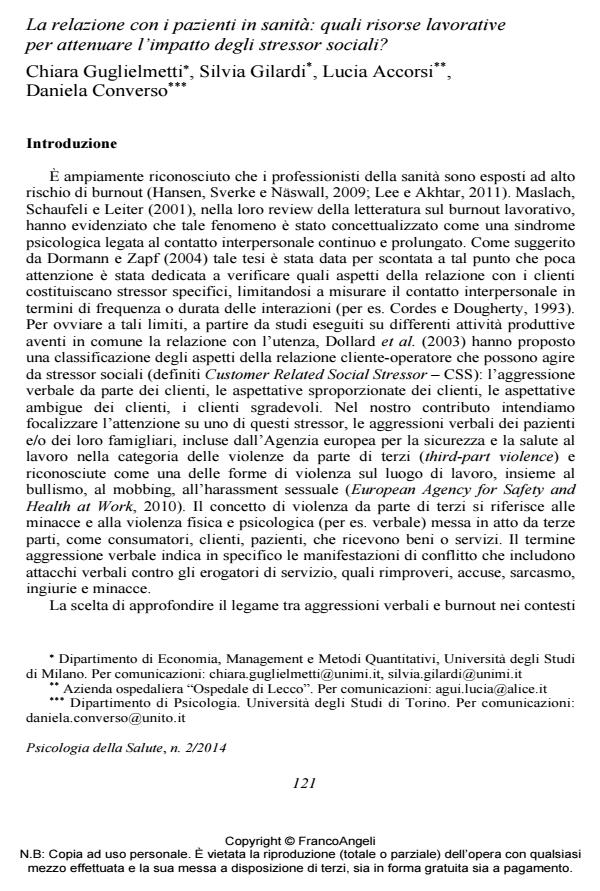La relazione con i pazienti in sanità: quali risorse lavorative per attenuare l’impatto degli stressor sociali?
Titolo Rivista PSICOLOGIA DELLA SALUTE
Autori/Curatori Chiara Guglielmetti, Silvia Gilardi, Lucia Accorsi, Daniela Converso
Anno di pubblicazione 2014 Fascicolo 2014/2
Lingua Italiano Numero pagine 17 P. 121-137 Dimensione file 265 KB
DOI 10.3280/PDS2014-002008
Il DOI è il codice a barre della proprietà intellettuale: per saperne di più
clicca qui
Qui sotto puoi vedere in anteprima la prima pagina di questo articolo.
Se questo articolo ti interessa, lo puoi acquistare (e scaricare in formato pdf) seguendo le facili indicazioni per acquistare il download credit. Acquista Download Credits per scaricare questo Articolo in formato PDF

FrancoAngeli è membro della Publishers International Linking Association, Inc (PILA)associazione indipendente e non profit per facilitare (attraverso i servizi tecnologici implementati da CrossRef.org) l’accesso degli studiosi ai contenuti digitali nelle pubblicazioni professionali e scientifiche
Ricerche nazionali e internazionali hanno mostrato che gli operatori sanitari si trovano ad affrontare episodi di violenza verbale e fisica con sempre maggior frequenza. Evidenze empiriche supportano l’ipotesi che comportamenti aggressivi dei pazienti possono generare processi di burnout. Scarsi sono però gli studi sulle risorse lavorative che consentono di attenuare l’impatto di tale stressor sociale sul benessere degli operatori nei contesti ospedalieri. Nel nostro contributo abbiamo analizzato se e in quali circostanze differenti tipi di risorse, emotive (supporto dei colleghi, supporto dei superiori) e cognitive (autonomia decisionale, significato del lavoro), moderino l’effetto negativo dell’aggressività verbale su burnout e benessere affettivo. Lo studio, di tipo trasversale, ha coinvolto il personale sanitario di un dipartimento chirurgico (133 operatori con un tasso di partecipazione del 67%). Lo strumento di rilevazione è stato un questionario self-report. Le analisi, effettuate attraverso una regressione gerarchica moderata, hanno evidenziato l’effetto diretto dei comportamenti aggressivi come importanti predittori del burnout e del benessere affettivo. Il supporto dei colleghi e dei superiori e, in misura minore, l’attribuzione di significato al lavoro moderano l’impatto negativo sull’esaurimento emotivo. Il benessere affettivo risulta essere moderato dal supporto dei colleghi e dalla percezione di autonomia lavorativa. Inoltre si è riscontrato che l’attribuzione di significato al proprio lavoro influenza positivamente il benessere nel caso di alta aggressività dei pazienti. Lo studio contribuisce a evidenziare gli aspetti socioorganizzativi che svolgono un’azione protettiva rispetto agli stressor sociali legati alla relazione con i pazienti nei contesti sanitari.
Parole chiave:Aggressività nei luoghi di lavoro, pazienti, nursing, burnout, salute occupazionale, Modello Demand Induced Strain Compensation.
- Users’ Support as a Social Resource in Educational Services: Construct Validity and Measurement Invariance of the User-Initiated Support Scale (UISS) Barbara Loera, Mara Martini, Sara Viotti, Daniela Converso, in Frontiers in Psychology /2016
DOI: 10.3389/fpsyg.2016.01248 - Who Cares for Those Who Take Care? Risks and Resources of Work in Care Homes Caterina Gozzoli, Diletta Gazzaroli, Chiara D’Angelo, in Frontiers in Psychology 314/2018
DOI: 10.3389/fpsyg.2018.00314 - Le dinamiche di interazione nella complessità del sistema sanitario: ruoli e responsabilità Giovanna Fanci, in SICUREZZA E SCIENZE SOCIALI 3/2019 pp.19
DOI: 10.3280/SISS2018-003003 - Customer Orientation and Leadership in the Health Service Sector: The Role of Workplace Social Support Andreina Bruno, Giuseppina Dell’Aversana, Anna Zunino, in Frontiers in Psychology 1920/2017
DOI: 10.3389/fpsyg.2017.01920 - Verbal Aggression from Care Recipients as a Risk Factor among Nursing Staff: A Study on Burnout in the JD-R Model Perspective Sara Viotti, Silvia Gilardi, Chiara Guglielmetti, Daniela Converso, in BioMed Research International /2015 pp.1
DOI: 10.1155/2015/215267 - Aging and Work Ability: The Moderating Role of Job and Personal Resources Daniela Converso, Ilaria Sottimano, Gloria Guidetti, Barbara Loera, Michela Cortini, Sara Viotti, in Frontiers in Psychology 2262/2018
DOI: 10.3389/fpsyg.2017.02262 - Comportamenti aggressivi e episodi di violenza a danno degli operatori sanitari: intervento di prevenzione e contrasto Maria Cristina Florini, Caryn Vallesi, Carla Baldassarri, in PSICOLOGIA DELLA SALUTE 2/2019 pp.143
DOI: 10.3280/PDS2019-002007
Chiara Guglielmetti, Silvia Gilardi, Lucia Accorsi, Daniela Converso, La relazione con i pazienti in sanità: quali risorse lavorative per attenuare l’impatto degli stressor sociali? in "PSICOLOGIA DELLA SALUTE" 2/2014, pp 121-137, DOI: 10.3280/PDS2014-002008